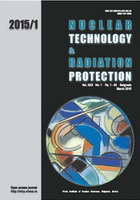
EXPERIMENTAL VERIFICATION OF GAMMA-EFFICIENCY CALCULATIONS FOR SCINTILLATION DETECTORS IN ANGLE 4 SOFTWARE
Pages: 35-46
Authors: Abouzeid A. Thabet, Aleksandar D. Dlabac, Slobodan I. Jovanoviĉ, Mohamed S. Badawi, Nikola N. Mihaljeviĉ, Ahmed M. El-Khatib, Mona M. Gouda, and Mahmoud I. Abbas
Abstract
ANGLE software for semiconductor detector efficiency calculations – long existing and widely accepted tool in quantitative gamma spectrometry – has been recently extended to scintillation NaI detectors. The extension features in the latest edition (ANGLE 4) and it is briefly outlined. Discretization of reference efficiency curve, meaning possibility of using ANGLE 4 for particular gamma energies without constructing the complete reference efficiency curve, is particularly emphasized. This yields both in enhanced practicality and higher accuracy, while reducing the potential for systematic errors. The present work is primarily focussed on experimental verification of ANGLE 4 for NaI detectors. Two detectors (2 x 2 and 3 x 3 inches) were employed in the experiment. Commercially calibrated gamma sources (in the forms of quasi point and cylinder) and homemade solutions (diluted from calibrated ones) were measured at various distances from the detector(s), ranging 0 cm to 50 cm. Energy range observed was 59 keV to 1408 keV. Versatility of counting conditions, in terms of detectors and sources used, gamma energies observed, source detector separations, etc., was aimed at creating as large experimental evidence as possible for verification purposes. Experimentally obtained efficiencies are compared with those calculated by ANGLE 4. Very good agreement is obtained – well within the experimental uncertainties – thus proving the reliability of the software.
Key words: gamma spectrometry, scintillation detector, efficiency calculation, ANGLE software, experimental verification
FULL PAPER IN PDF FORMAT (10.66 MB)
